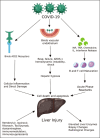Insight into COVID-19 associated liver injury: Mechanisms, evaluation, and clinical implications
- PMID: 39006140
- PMCID: PMC11237249
- DOI: 10.14744/hf.2023.2023.0025
Insight into COVID-19 associated liver injury: Mechanisms, evaluation, and clinical implications
Abstract
COVID-19 has affected millions worldwide, causing significant morbidity and mortality. While predominantly involving the respiratory tract, SARS-CoV-2 has also caused systemic illnesses involving other sites. Liver injury due to COVID-19 has been variably reported in observational studies. It has been postulated that liver damage may be due to direct damage by the SARS-CoV-2 virus or multifactorial secondary to hepatotoxic therapeutic options, as well as cytokine release syndrome and sepsis-induced multiorgan dysfunction. The approach to a COVID-19 patient with liver injury requires a thorough evaluation of the pattern of hepatocellular injury, along with the presence of underlying chronic liver disease and concurrent medications which may cause drug-induced liver injury. While studies have shown uneventful recovery in the majority of mildly affected patients, severe COVID-19 associated liver injury has been associated with higher mortality, prolonged hospitalization, and greater morbidity in survivors. Furthermore, its impact on long-term outcomes remains to be ascertained as recent studies report an association with metabolic-fatty liver disease. This present review provides insight into the subject by describing the postulated mechanism of liver injury, its impact in the presence of pre-existing liver disease, and its short- and long-term clinical implications.
Keywords: COVID-19 associated liver injury; SARS-CoV-2; cytokine release syndrome.
Conflict of interest statement
The authors have no conflict of interest to declare.
Figures
Similar articles
-
Pathogenetic Mechanisms of Liver-Associated Injuries, Management, and Current Challenges in COVID-19 Patients.Biomolecules. 2023 Jan 3;13(1):99. doi: 10.3390/biom13010099. Biomolecules. 2023. PMID: 36671484 Free PMC article. Review.
-
SARS-CoV-2 induced liver injury: Incidence, risk factors, impact on COVID-19 severity and prognosis in different population groups.World J Gastroenterol. 2023 Apr 28;29(16):2397-2432. doi: 10.3748/wjg.v29.i16.2397. World J Gastroenterol. 2023. PMID: 37179584 Free PMC article. Review.
-
COVID-19 and Indirect Liver Injury: A Narrative Synthesis of the Evidence.J Clin Transl Hepatol. 2021 Oct 28;9(5):760-768. doi: 10.14218/JCTH.2020.00140. Epub 2021 Jun 16. J Clin Transl Hepatol. 2021. PMID: 34722191 Free PMC article. Review.
-
Unraveling the Molecular and Cellular Pathogenesis of COVID-19-Associated Liver Injury.Viruses. 2023 May 30;15(6):1287. doi: 10.3390/v15061287. Viruses. 2023. PMID: 37376587 Free PMC article. Review.
-
COVID-19 and liver injury: An ongoing challenge.World J Gastroenterol. 2023 Jan 14;29(2):257-271. doi: 10.3748/wjg.v29.i2.257. World J Gastroenterol. 2023. PMID: 36687117 Free PMC article. Review.
Cited by
-
The Role of Dental-derived Stem Cell-based Therapy and Their Derived Extracellular Vesicles in Post-COVID-19 Syndrome-induced Tissue Damage.Stem Cell Rev Rep. 2024 Nov;20(8):2062-2103. doi: 10.1007/s12015-024-10770-y. Epub 2024 Aug 16. Stem Cell Rev Rep. 2024. PMID: 39150646 Review.
References
-
- Wise J. Covid-19: WHO declares end of global health emergency. BMJ. 2023;381:1041. - PubMed
Publication types
LinkOut - more resources
Full Text Sources
Miscellaneous

